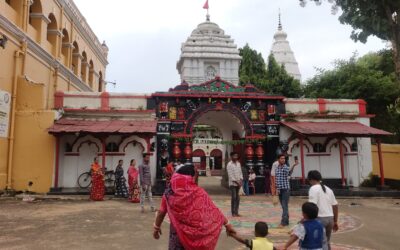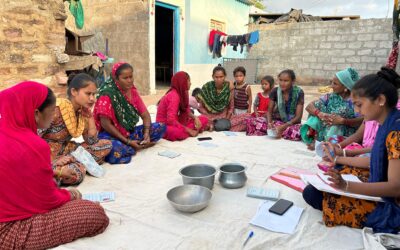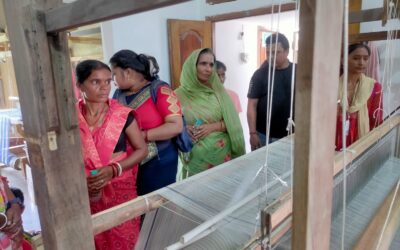As a part of my field visits to various Panchayats around Kutch, I got to understand the way local administration chose to deal with the pandemic. This process helped me to build knowledge about the steps taken to control the spread of pandemic at the policy level, in terms of where were the gaps and how people filled those gaps. In fact, I now know that there is much to learn from local, decentralized government structures and how the representatives managed to contain the Corona virus amidst chaos throughout the countryside, much as “ordinary” citizens who engage in voluntary public service.
While every panchayat made sure that they seek information with the help of NGOs such as SETU Abhiyan and Kutch Mahila Vikas Sangathan, they distributed free masks, sanitizers and gloves on their own. They also spread knowledge around guidelines and best practices during the pandemic.
What has emerged from each panchayat are the unique traits of each village, its needs, circumstances and perhaps the most important, the interventions that were carried out. One can see innovations across the Kutch district.

Kotda Madh Juth (Group) Gram Panchayat lies in the Lakhapat block of Kutch District, around 95 km west of Bhuj. This Panchayat consists of four villages – Sukhapar Vandh, Kalravandh, Murachban, and Kotda Madh. The Panchayat, Sarpanch and its citizens have become role models in their approach to deal with the pandemic, with their exceptional participatory approach and focus on regularly addressing each other’s needs with efficiency.
A committee of 10-12 people was formed by the panchayat to take responsibility of ensuring that everyone’s needs were met. This committee included the Sarpanch, Adhambhai Rayma, the principal of the primary school, Hiren Bhatti, teachers and volunteers. After making sure that the volunteers were less prone to the virus, being younger in age, only 10 people were allowed to move between villages for work. They would not enter homes, but would transfer resources, for example, from a shop to someone’s house.
Their work included collecting ration cards, making a list of people’s requirements and then home-delivering it to them. The Panchayat shared mobile numbers among people, so that if anyone needs anything, they could call a number and would receive the needed items at home, to ensure that no one had to step out of their house even once.

A blended mode of education is being followed right now, with sessions being conducted both online and offline, as teachers visit the homes of the enrolled children. In a day, each teacher teaches around 5 children, as per a schedule followed by them. If there are any questions, a maximum of 5 children are allowed to come to the school and clarify their doubts.
The 10-people committee who were outdoors, went to the children’s homes to give textbooks, notebooks and stationery. This team of 10 people was doing everything themselves. We wish we could open the school but we also have to listen to the government guidelines and not gather 50 children or more at once.
– Hiren Bhatti, Primary School Principal
The school is also adapting to new methods, by sharing links to Youtube videos recorded with solutions to questions prepared by the teachers. They are sent on a common Kotda Madh panchayat school group, so that it can be used as an aid by the students in case they miss the session(s).
Collective action is only rarely so effective. An exemplary effort by the Panchayat of Kotda Madh and the young volunteers did not allow the repercussions of a dangerous pandemic and lockdown to be felt. It brings into light what happens when decision-making and relief processes involve different perspectives and allow for the potential for help to be fully harnessed.

Vadasar is a village placed around 17 km away from Bhuj, in the district of Kutch, Gujarat. With a population of 947 citizens as per the 2011 census, it forms a Gram Panchayat with Priti Ben as Sarpanch. What became important upon the announcement of the lockdown and “officiation” of the Coronavirus pandemic was to relay the right information, which was done by attaching loudspeakers and sound systems to cars. The idea was to make sure that everyone received the same, accurate and verified information. Every street, every area of the village had to be covered to communicate the rules and regulations set by the central government.
Priti Ben, the Sarpanch, took the initiative to buy materials to make masks. They were cut and stitched by locals, who in the process were able to achieve gainful employment. She then got them distributed ward-wise to everyone in the village. This becomes an important point in this case, i.e. an initiative to do what was needed for people because of the ability to understand their perspectives and concerns. As a step towards equality, it was ensured that all households, regardless of economic, social or financial background, were provided with ration.
We noticed that the poor were not getting ration, and decided that each and everyone should receive it. 100% households were then provided ration.
– Priti Ben, Sarpanch
Since the inception of the Mid-Day Meal Scheme, it has gone through many revisions, the latest in 2007 (with revisions made since 2009 onwards to improve the implementation of the scheme). Naturally, this also became a part of the efforts made by the local government to ease the population, especially young children, into the lockdown period.
An overwhelming number of children were unable to get these meals, and so the Panchayat decided to provide relief to non-recipients in the form of either monetary aid or dry ration.
As for livelihoods, such as those of the farmers producing perishable items, a solution was found to benefit the entire village. Tie-ups were formed with the “sabzi-wallahs”, such that vegetable and fruits were sourced by the Panchayat and distributed to every house directly. For those below 18 and above 65 years of age, strict rules prohibited their movement outside their homes, and so volunteers took over the responsibility of travelling and receiving supplies on their behalf.

In another display of initiative, the Sarpanch herself became a part of this process, making sure it ran smoothly. In a similar fashion to that of vegetables, free fruits were also distributed among the residents, through a tractor that let them take what they wanted.
Vadasar Panchayat’s work is a display of what can be done with existing resources and time. The difference is made when an understanding of the present needs is gained in time, equitably and responsibly. Local resources, knowledge and participatory methods form an important part of this.




0 Comments